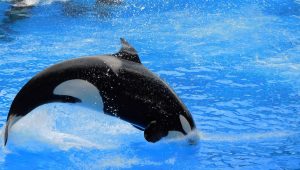Dolphins are not just smart and happy fishes that make you giggle when they entertain you. They are one of the smartest mammals and they’re actually not called a ‘fish’. If you’re wondering why then you should know one of the most general dolphin facts. Marine animals like whales and dolphins are not termed as fishes but are called cetacea. Whales and dolphins can be termed as each other ‘cousins’ but are definitely different species altogether.
Whales types are divided into two categories, one is a toothed whale and then the baleen whales. The toothed ones include sperm whales, killer whales, and dolphins. Dolphins are also toothed whales but are a different type. While Baleen whales filter their edibles out of the water, like blue whales and humpbacks, dolphins have a different way of doing that. Well, it is time you get into the details about what makes dolphins incredible species living in the unexplored oceans.
Table of Contents
Dolphin facts you must know
You might be interested in marine life or simply finding facts to tell your child. Dolphins are definitely one such marine animal that you must know about and educate others too. Find out the different reasons why they’re one of the most adorable and special parts of the marine world:
Smartness
Do you know that the largest brain in the world is owed by the sperm whale? Their brains weigh more than nine kilos and are almost seven times larger than the human brain. The killer whales or orcas have the second-largest brains in the world that weigh almost six kilos.
Elephants also have large brains, but when it comes to the dolphin family, they’re not smart enough. An average dolphin’s brain would weight 1,500 grams while human brains are around 1,200 grams.
The cerebellum in cetaceans are more than any other mammals. Researchers suggest that it indicates high intelligence level. The brain surface of bottlenose dolphins is more than 1,400 square centimeters and much more than humans.
Well, this is not just a general comparison but also shows the connection between the motive areas and sensorial of their brain. The mammals are sensitive to stress and pain, and these too show their emotional intelligence.

Tools they use
Many people believe that primates are only species that uses tools for activities, but that’s not true. According to dolphin facts, some wild ones have been seen to use sea sponges. These dwell in the bottom of the water and are filter-feeding invertebrates that are plant lookalikes. The activity protects their snout from getting scratched while they hunt for food.
Mothers give such sponges to dependent calves just like researches show how infant dolphins wear tiny sponges on their snouts to swim close to the mothers.
They talk to each other
You will be delighted to know that dolphins can talk to each other. They use whistles, signs, and call each other names. Dolphin facts also state that they can mimic each other movements and that’s how they often entertain humans too.
It is quite interesting to see what both whales and dolphins can do with their large brains. They also try to maintain communication that keeps them closer to their groups. Together they fight predators like sharks and they cooperate in that process.
Human brains have a large part devoted to cortical functions. Their ability to compute what lies in the future and remember past makes them have a sense of ethics and aesthetics. Dolphins have a similar state of development in their brains. Their capabilities are alike but they have interests different from that of humans.
The most obvious difference is that we live on land and they live in the sea. We have the power to manipulate the environment, but dolphins can adjust in their given habitat. Humans mostly depend on their eyesight to collect information of the world and give out similarly. But dolphins depend on sound in such a case. Their biological sonar pierce into the murky ocean to figure out what’s happening.

Stress can kill dolphins
In a stressful situation, the catecholamine or adrenal gland secretions cause irreparable damage to the system of our heart. It easily explains why dolphins, even after escaping from nets or drive fishers tend to die when they get back to their habitat.
Dolphin sonar
According to scientists, dolphins can make acoustical holographic visions from interlacing sonic output. Most people know that dolphins can see inside bodies of fellow dolphins and other marine animals. But this happens because dolphin sonar passes through water and doesn’t reflect until it hits their bone or an air sac. Since marine animals have more than 50% of water in their bodies, the sonar helps them see through their bodies. In other words, dolphins can read through emotions of fellow dolphins and see through their bodies like x-rays.
Dolphin senses
The senses of dolphins are as special as they are. Check out how these make them more powerful:
1. Sight
The mammals have the ability to focus on their eyesight because of their curvy characteristics. They can see through both inside the water and outside!
2. Hearing
Dolphin holes are small but they are sharp for hearing. Having large ears could affect the ability to swim. According to dolphin facts, the sounds they obtain through their thin mandibular bones get transferred into their inner ear. There is a fatty material surrounding their eardrum that finally enables them to hear.
Dolphins have 2-3 times as much as cells in their ears than humans do. It gives them the ability to distinguish between high-frequency waves and tones made by other dolphins.
3. Echolocation
Sounds emitted by dolphins are known as echolocation and these have a high frequency. The average speed is 2, 00,000 cycles every second. While swimming normally, dolphins have low-frequency sounds, but when they find something interesting, they start making high-frequency noise.
4. Communication
The mammals talk to each other with the help of whistles. The bottlenose dolphins can create boons that exceed 230 decibels and can help hunt fishes. These mammals can think, reason, remember the past, and plan future.
Can you imagine that dolphins can think in a certain way about you? Probably that is something unique, funny, but something that suits their understanding of having humans around.
If you put yourself in the place of dolphins, how would you have perceived human activities in oceans? Would you still have the opinions of what you do now? What would dolphins think about us? Find out more about dolphin facts to have all these answered.

Biology
It is time to find out how dolphins are different from fishes or why they aren’t at all fishes:
1. Skin
The surface of dolphin skin is covered with micro folds that direct water flow and reduce turbulence as they swim.
At an average, dolphin skin is around 0.08 to 0.16 inches thick and that’s around 10 to 20 times more than any mammal on land.
The pressure change is sensitive on dolphin skin around its blowhole. This allows the mammal, to open or close its hold while emerging to the surface or diving back to the water.
There is a layer of fat surrounding the body and right beneath the skin. This part is usually thick and avoids dispersion of heat. It makes the body rounded and balances weight. The bodily feature makes them float easily.
2. Fins
A dolphin’s fin doesn’t just serve as a swimming aid, but they also work as heat exchangers. The fins don’t contain a fat layer, but also have lots of blood vessels. The tail fin of dolphins is largest and helps them swim fast. The thin portion of their body that lies close to the tail, fin helps animals move efficiently.
3. Heart
Depending on the activity of the animal, the rhythm of their heartbeat keeps varying. On the surface, the beat ranges anywhere from 70 to 100 every minute. When they are underwater, they range from around 30 to 40 beats per minute.
4. Breathing
Most dolphins breathe two to three times within one minute. But if they are underwater for a long time, they can breathe for 15 to 16 times in one minute. In overall, the time needed to take a breath is around 0.3 seconds.
5. Eating
Most dolphins eat small fishes and squid. But they can easily adapt to an environment where they eat what is available. They can even eat pelagic prey if they find them. You will be surprised to know those dolphin teeth are not used for chewing. They just help them grasp the fishes and then they swallow them down.
6. Reproduction
Dolphin facts state that the mammals have ‘courtship’ where two dolphins are found dancing, rubbing bodies against each other, and touching snouts. They mate their abdomens for a short span of time to process reproduction.
When a baby dolphin is born, it needs to go the surface to breathe. The mother guides its and wakes it up. Only in this way can they take their first breath.
Dolphin species
Let’s discuss some of the most common dolphin species in the world:
1. Bottlenose dolphins
Bottlenose dolphins are the most common dolphin species that you’d find in aquariums. They are the ones that are usually captured and tamed. During birth, these dolphins are generally 2.8 ft to 4 ft in length. They live almost 30 years or more.
Bottlenose dolphins swim at 30 miles per hour and can dive as deep at 1,960 ft. These are mostly coastal species of dolphins. The female ones have sexual maturity when they are around 10 years old, while males one at 13 years old. Dolphins at the Florida Coast mate during spring and autumn, while they do the same during summers in the European coast.
Bottlenose dolphins can be as long as 13 ft and weight 1420 pounds. When looking for food, they usually come together in groups and hunt together. When their prey is in the open sea, the dolphins surround them and feed on them. The mammals swim counterclockwise forming parallel lines.
2. Killer Whale or Orca
Orcas are the largest of dolphin species and their pod sizes can range from two to 50. The centerpiece of orca dolphins is a female and calf. When the calf is a female too, it stays with the mother till it dies. When calves are male, he is the part of the pod but not the member of the family.
Orcas cannot dive more than 330 ft while hunting. When they’re not hunting, they can go almost 3282 ft and hold the breath for 20 minutes straight. These mammals have tiny fishes and can be as large as 27.9 ft and weigh more than 11 tons.
The female orcas are lighter than the male and they all live for more than 35 years, while some are as old at 50. Orcas swim 34.2 miles per hour and their mating season is spring.

4. Atlantic Spotted Dolphin
As the name suggests, these dolphins live in the Atlantic Ocean and prefer to be by the coastal regions. The young ones don’t have white spots but as they grow, they do. Since these dolphins are dark in color, they can disappear into the ocean floor even if you spot them from above. But if you see their white belly up, they will shine under the sun.
Both Bottlenose and Atlantic Spotted Dolphins have 300 teeth in their lower and upper combined. These dolphins don’t grow longer than 7.5 ft and tend to weight 315 pounds. During birth, they can be around 2.5 to 4 ft long.
4. Spinner Dolphin
The maximum length of spinner dolphins is 8.9 ft and the most they can weigh is 170 pounds. These dolphins are much known for their acrobatics skills. As per research, these dolphins make such movements in order to prove identity or to communicate with fellow dolphins. They also click and whistle and they prefer staying in the tropical waters. These dolphins swim at 12.4 miles in an hour and can live for 20 years. At birth, they weigh around a foot long and sometimes smaller in size.
The dolphin facts surely help us analyze how special these creatures are and make us more curious about other marine animals. Dolphins are fun, adorable, and probably smarter than humans. They are definitely one of nature’s beauty and makes us realize how beautiful our world is.

